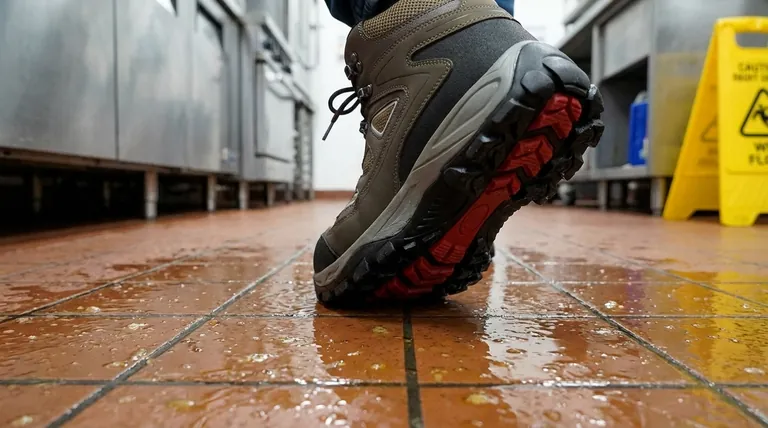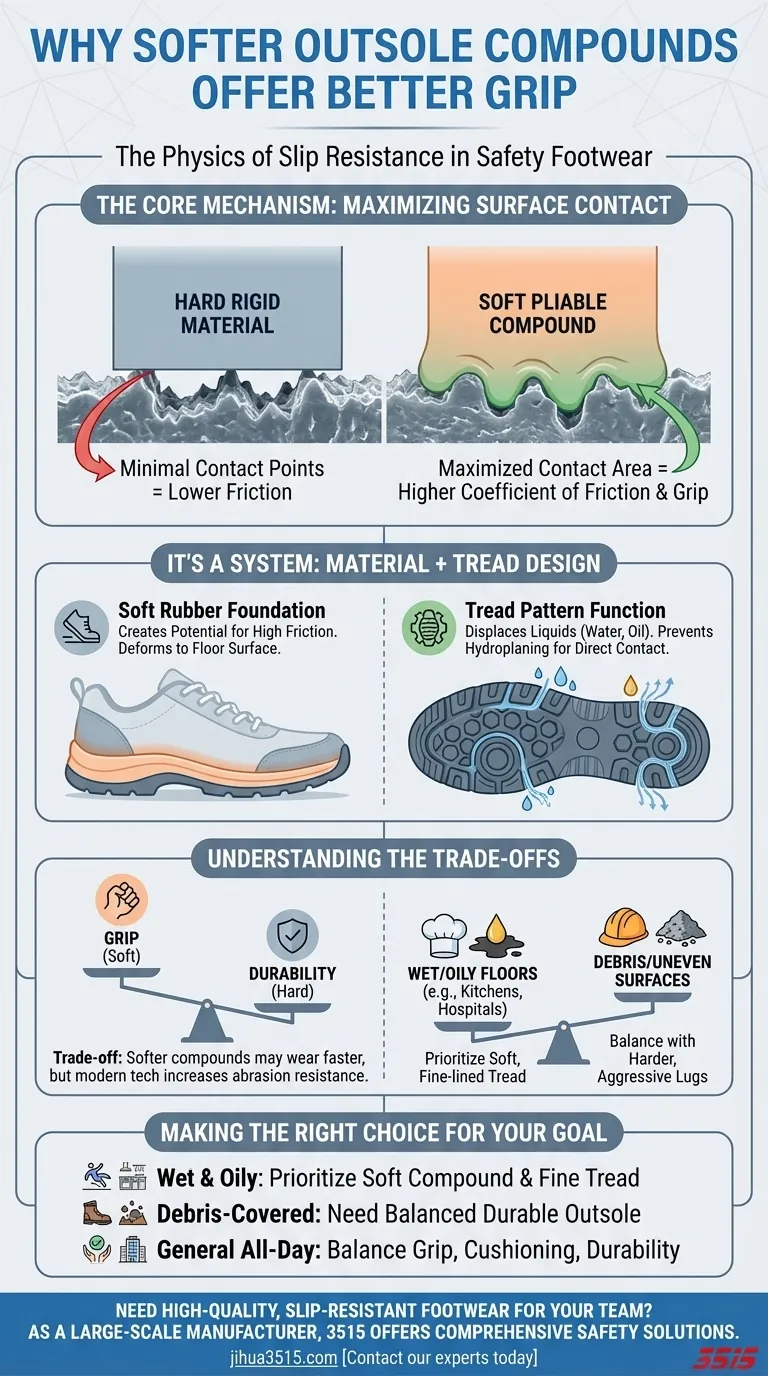The short answer is grip. Slip-resistant shoes use softer outsole compounds because a more pliable material can better conform to microscopic irregularities on a floor surface. This maximization of surface contact is what generates the high level of friction needed to prevent slips on wet or oily floors.
A shoe's slip resistance is not just about the material's softness; it's a carefully engineered system. The soft compound creates the potential for high friction, while the outsole's tread pattern is designed to clear away contaminants like water and oil, allowing that friction to be effective.

How Softer Compounds Generate Grip
To understand why a softer material is superior for slip resistance, we need to look at the physics of friction on a microscopic level.
Maximizing Surface Contact
A truly flat surface doesn't exist. Every floor, no matter how smooth it appears, is covered in microscopic peaks and valleys. A soft, pliable rubber outsole can deform and press into these tiny imperfections.
This creates significantly more contact area between the shoe and the floor compared to a hard, rigid material that would only touch the very highest peaks.
The Direct Link to Friction
Friction is the force that resists motion between two surfaces in contact. The amount of friction is directly related to how much of the surface is actually touching.
By increasing the surface contact area, the softer compound creates a higher coefficient of friction. This is the fundamental property that prevents your foot from sliding out from under you.
It's a System: Material and Tread Design
While the soft compound is the foundation of grip, it cannot work alone, especially when liquids are introduced. The design of the outsole's tread is the other half of the equation.
Preventing a Liquid Barrier
When you step on a wet or oily floor, a thin film of liquid can get trapped under your shoe. This can cause you to "hydroplane," where your shoe loses contact with the floor entirely.
This is where tread patterns become critical. The sole isn't just flat; it has carefully designed grooves and channels.
How Tread Patterns Displace Liquid
The shapes of the tread—often hexagonal, circular, or intricate micro-channels—are not for aesthetics. They are engineered to do one job: move liquid out from under the shoe.
As you apply pressure by stepping, the liquid is squeezed into these grooves and channeled away from the sole's contact points. This allows the soft rubber to make direct contact with the floor, ensuring a secure grip.
Understanding the Trade-offs
Using softer materials for outsoles is an intentional engineering choice that comes with specific compromises. Understanding these helps you evaluate a shoe's true performance.
Durability vs. Grip
The primary trade-off is often durability. Historically, softer materials wear down faster than harder ones.
However, modern slip-resistant compounds are highly engineered. Manufacturers often design them for high abrasion resistance to counteract this tendency, but it remains a key principle. A shoe designed for maximum grip in a kitchen may not last as long if worn daily on rough pavement.
Specialization for the Environment
Slip-resistant shoes are highly specialized. A sole designed for a greasy kitchen floor is optimized for a different type of hazard than one designed for an icy sidewalk or a dusty construction site.
The combination of a specific rubber compound and tread pattern is tuned for a particular set of conditions, such as those found in hospitals, manufacturing facilities, or commercial kitchens.
Making the Right Choice for Your Goal
Your choice of footwear should be directly informed by the primary hazards you face in your environment.
- If your primary focus is wet or oily indoor surfaces (e.g., kitchens, hospitals): Prioritize shoes with certified soft rubber compounds and intricate, fine-lined tread patterns designed to displace thin liquids.
- If your primary focus is debris-covered or uneven surfaces: You may need a more balanced outsole that combines slip resistance with a harder, more durable compound and deeper, more aggressive lugs.
- If your primary focus is general all-day comfort with moderate risk: Look for a shoe that balances a slip-resistant design with cushioning and overall durability, even if it doesn't have the highest slip-resistance rating.
Ultimately, understanding how material and design work together empowers you to select footwear that provides a genuine, measurable increase in safety.
Summary Table:
| Feature | Why It Matters for Slip Resistance |
|---|---|
| Softer Outsole Compound | Conforms to microscopic floor imperfections, maximizing surface contact and friction. |
| Intricate Tread Pattern | Channels water and oil away, preventing hydroplaning and allowing the sole to grip the floor. |
| Engineered for Specific Hazards | Optimized for environments like kitchens, hospitals, or manufacturing floors. |
| Trade-off: Durability | Softer compounds may wear faster, but modern materials are engineered for abrasion resistance. |
Need high-quality, slip-resistant footwear for your team?
As a large-scale manufacturer, 3515 produces a comprehensive range of safety footwear for distributors, brand owners, and bulk clients. Our expertise ensures your footwear combines the latest in slip-resistant compound technology with durable tread designs tailored to your specific work environment.
Contact our experts today to discuss your safety footwear needs and receive a customized solution.
Visual Guide

Related Products
- Safety Footwear Wholesale Manufacturer for Custom OEM/ODM Production
- Advanced KPU Athletic Safety Shoe with Steel Toe Cap Anti-Slip Rotary Lacing System
- Premium Suede Sport Safety Shoes for Wholesale & Bulk Orders
- Wholesale Premium Waterproof Nubuck Safety Shoes Boots
- Wholesale Safety Footwear Manufacturer for Bulk & Custom OEM Orders
People Also Ask
- How do safety shoes contribute to cost savings for companies? A Strategic Investment in Risk and Cost Management
- Is it normal to wear shoes in the house? A Guide to Hygiene, Comfort & Culture
- What are the differences between steel toe, composite toe, and alloy toe Wellington boots? Choose the Right Safety Toe for Your Job
- What are OSHA approved shoes? Understanding the Correct Standards for Workplace Safety
- What are the cultural perspectives on wearing shoes in the house? A Guide to Home Etiquette & Hygiene



















